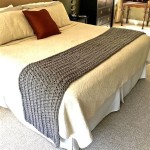How To Extend A Wooden Bed Frame
Extending a wooden bed frame can be a cost-effective way to increase sleeping space without purchasing a new bed. Whether adapting a smaller bed for a growing child or creating a larger sleeping area in a guest room, several methods provide viable solutions. Careful planning and accurate measurements are crucial for a successful extension.
Assessing the Existing Bed Frame
Before beginning any extension project, thoroughly examine the existing bed frame. Identify the type of wood, joinery methods, and overall structural integrity. This assessment determines the most appropriate extension method and ensures the modified frame remains stable and safe.
Method 1: Adding a Bed Frame Extender
Bed frame extenders provide a simple, non-invasive solution for increasing length or width. These pre-fabricated units fit between the existing frame and the headboard or footboard. They are readily available in various sizes and materials and typically require minimal tools for installation. This method is ideal for minor adjustments and requires no permanent modifications to the original frame.
Method 2: Extending with Matching Lumber
For more substantial extensions or custom modifications, using matching lumber offers greater flexibility. Select lumber of the same species and dimensions as the existing frame for a seamless appearance. This method requires accurate cutting and strong joinery techniques to maintain structural integrity.
Essential Tools and Materials
Gather all necessary tools and materials before starting the project. This preparation ensures a smooth and efficient workflow. Common requirements include:
- Measuring tape
- Saw (hand saw, circular saw, or miter saw)
- Drill and appropriate drill bits
- Screwdriver (or drill with screwdriver bits)
- Wood glue
- Wood screws
- Sandpaper
- Wood stain or paint (if desired)
- Safety glasses and gloves
Step-by-Step Guide for Extending with Lumber
Extending a bed frame with lumber involves several key steps:
- Measure and cut the lumber to the desired length and width.
- Pre-drill pilot holes to prevent wood splitting.
- Apply wood glue to the joining surfaces.
- Secure the extension pieces to the existing frame using wood screws.
- Sand any rough edges or surfaces.
- Apply wood stain or paint to match the original frame, if desired.
Reinforcing the Extended Frame
Reinforcements provide additional stability and prevent sagging or wobbling, particularly for significant extensions. Several reinforcement techniques can be applied:
- Adding support legs in the center of the extended section.
- Installing cross braces or corner brackets.
- Using thicker lumber for the extension pieces.
Considerations for Different Bed Frame Types
Different bed frame types require specific considerations during extension. Platform beds, for instance, may necessitate extending the platform slats along with the frame. Four-poster beds require extending the posts and canopy supports proportionally. Careful analysis of the existing frame design is vital for determining the appropriate modifications.
Dealing with Existing Joinery
Existing joinery impacts how the extension integrates with the original frame. Understanding common joinery types, such as dovetails, mortise and tenon, or dowel joints, informs the best approach. Replicating the original joinery ensures a strong and aesthetically consistent outcome. Alternatively, using compatible modern joinery techniques can simplify the process while maintaining structural integrity.
Finishing Touches and Maintenance
After completing the extension, ensure all surfaces are smooth and free of splinters by sanding thoroughly. Apply wood stain or paint to match the existing frame, if desired. Regular maintenance, such as tightening screws and inspecting joints, will help preserve the extended frame’s longevity and stability. Protecting the wood with a sealant can also prevent damage from moisture and wear.
Safety Precautions
Prioritizing safety throughout the project is paramount. Always wear appropriate safety gear, including safety glasses and gloves. Use tools correctly and follow manufacturer instructions. Ensure the extended frame is stable and secure before use. If significant structural modifications are necessary, consulting a professional carpenter or engineer may be advisable.

An Extending Bed In My Diy Van Conversion Vandog Traveller

Diy Easy Slipcovered Headboard Tutorial Plus How To Extend A Low Bedhead The Painted Hive

An Extending Bed In My Diy Van Conversion Vandog Traveller Conversions Camper Wood Frame

An Extending Bed In My Diy Van Conversion Vandog Traveller

Sprinter Camper Van Build Out Ray Phung Photography

Image 2 Extra Width Board To Extend Existing Bed Base Was Added With Hinges And Fasteners The New Adjustable Wooden Slats Foam Mattress Frame

An Extending Bed In My Diy Van Conversion Vandog Traveller

An Extending Bed In My Diy Van Conversion Vandog Traveller

1 I Converted A Second Hand Single Bed Into Pull Out Guest When Folded Away It S The Standard And E Diy Sofa

Mattress Extender Block Fills The Gap At End Of Bed
Related Posts







